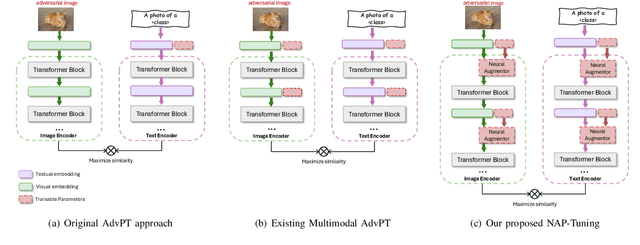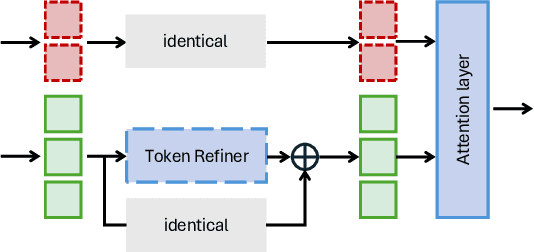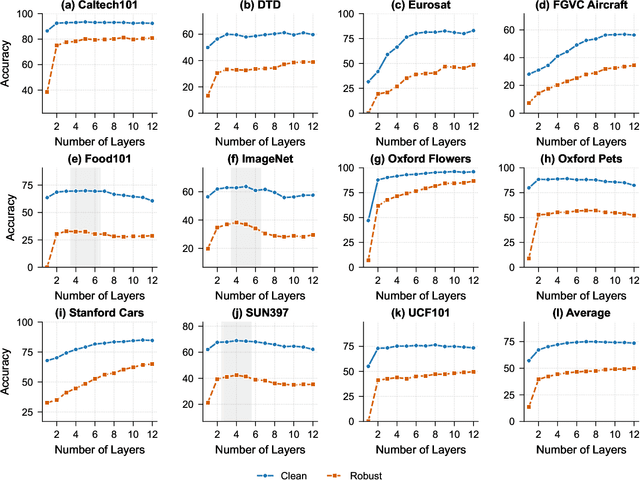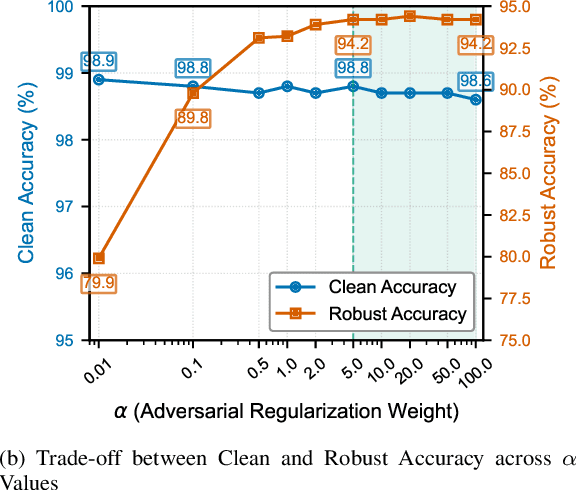Jiaming Zhang
SAM 2++: Tracking Anything at Any Granularity
Oct 22, 2025Abstract:Video tracking aims at finding the specific target in subsequent frames given its initial state. Due to the varying granularity of target states across different tasks, most existing trackers are tailored to a single task and heavily rely on custom-designed modules within the individual task, which limits their generalization and leads to redundancy in both model design and parameters. To unify video tracking tasks, we present SAM 2++, a unified model towards tracking at any granularity, including masks, boxes, and points. First, to extend target granularity, we design task-specific prompts to encode various task inputs into general prompt embeddings, and a unified decoder to unify diverse task results into a unified form pre-output. Next, to satisfy memory matching, the core operation of tracking, we introduce a task-adaptive memory mechanism that unifies memory across different granularities. Finally, we introduce a customized data engine to support tracking training at any granularity, producing a large and diverse video tracking dataset with rich annotations at three granularities, termed Tracking-Any-Granularity, which represents a comprehensive resource for training and benchmarking on unified tracking. Comprehensive experiments on multiple benchmarks confirm that SAM 2++ sets a new state of the art across diverse tracking tasks at different granularities, establishing a unified and robust tracking framework.
Efficient Forward-Only Data Valuation for Pretrained LLMs and VLMs
Aug 13, 2025Abstract:Quantifying the influence of individual training samples is essential for enhancing the transparency and accountability of large language models (LLMs) and vision-language models (VLMs). However, existing data valuation methods often rely on Hessian information or model retraining, making them computationally prohibitive for billion-parameter models. In this work, we introduce For-Value, a forward-only data valuation framework that enables scalable and efficient influence estimation for both LLMs and VLMs. By leveraging the rich representations of modern foundation models, For-Value computes influence scores using a simple closed-form expression based solely on a single forward pass, thereby eliminating the need for costly gradient computations. Our theoretical analysis demonstrates that For-Value accurately estimates per-sample influence by capturing alignment in hidden representations and prediction errors between training and validation samples. Extensive experiments show that For-Value matches or outperforms gradient-based baselines in identifying impactful fine-tuning examples and effectively detecting mislabeled data.
Hallucinating 360°: Panoramic Street-View Generation via Local Scenes Diffusion and Probabilistic Prompting
Jul 09, 2025



Abstract:Panoramic perception holds significant potential for autonomous driving, enabling vehicles to acquire a comprehensive 360{\deg} surround view in a single shot. However, autonomous driving is a data-driven task. Complete panoramic data acquisition requires complex sampling systems and annotation pipelines, which are time-consuming and labor-intensive. Although existing street view generation models have demonstrated strong data regeneration capabilities, they can only learn from the fixed data distribution of existing datasets and cannot achieve high-quality, controllable panoramic generation. In this paper, we propose the first panoramic generation method Percep360 for autonomous driving. Percep360 enables coherent generation of panoramic data with control signals based on the stitched panoramic data. Percep360 focuses on two key aspects: coherence and controllability. Specifically, to overcome the inherent information loss caused by the pinhole sampling process, we propose the Local Scenes Diffusion Method (LSDM). LSDM reformulates the panorama generation as a spatially continuous diffusion process, bridging the gaps between different data distributions. Additionally, to achieve the controllable generation of panoramic images, we propose a Probabilistic Prompting Method (PPM). PPM dynamically selects the most relevant control cues, enabling controllable panoramic image generation. We evaluate the effectiveness of the generated images from three perspectives: image quality assessment (i.e., no-reference and with reference), controllability, and their utility in real-world Bird's Eye View (BEV) segmentation. Notably, the generated data consistently outperforms the original stitched images in no-reference quality metrics and enhances downstream perception models. The source code will be publicly available at https://github.com/Bryant-Teng/Percep360.
NAP-Tuning: Neural Augmented Prompt Tuning for Adversarially Robust Vision-Language Models
Jun 15, 2025



Abstract:Vision-Language Models (VLMs) such as CLIP have demonstrated remarkable capabilities in understanding relationships between visual and textual data through joint embedding spaces. Despite their effectiveness, these models remain vulnerable to adversarial attacks, particularly in the image modality, posing significant security concerns. Building upon our previous work on Adversarial Prompt Tuning (AdvPT), which introduced learnable text prompts to enhance adversarial robustness in VLMs without extensive parameter training, we present a significant extension by introducing the Neural Augmentor framework for Multi-modal Adversarial Prompt Tuning (NAP-Tuning).Our key innovations include: (1) extending AdvPT from text-only to multi-modal prompting across both text and visual modalities, (2) expanding from single-layer to multi-layer prompt architectures, and (3) proposing a novel architecture-level redesign through our Neural Augmentor approach, which implements feature purification to directly address the distortions introduced by adversarial attacks in feature space. Our NAP-Tuning approach incorporates token refiners that learn to reconstruct purified features through residual connections, allowing for modality-specific and layer-specific feature correction.Comprehensive experiments demonstrate that NAP-Tuning significantly outperforms existing methods across various datasets and attack types. Notably, our approach shows significant improvements over the strongest baselines under the challenging AutoAttack benchmark, outperforming them by 33.5% on ViT-B16 and 33.0% on ViT-B32 architectures while maintaining competitive clean accuracy.
FedFACT: A Provable Framework for Controllable Group-Fairness Calibration in Federated Learning
Jun 04, 2025Abstract:With emerging application of Federated Learning (FL) in decision-making scenarios, it is imperative to regulate model fairness to prevent disparities across sensitive groups (e.g., female, male). Current research predominantly focuses on two concepts of group fairness within FL: Global Fairness (overall model disparity across all clients) and Local Fairness (the disparity within each client). However, the non-decomposable, non-differentiable nature of fairness criteria pose two fundamental, unresolved challenges for fair FL: (i) Harmonizing global and local fairness in multi-class classification; (ii) Enabling a controllable, optimal accuracy-fairness trade-off. To tackle the aforementioned challenges, we propose a novel controllable federated group-fairness calibration framework, named FedFACT. FedFACT identifies the Bayes-optimal classifiers under both global and local fairness constraints in multi-class case, yielding models with minimal performance decline while guaranteeing fairness. To effectively realize an adjustable, optimal accuracy-fairness balance, we derive specific characterizations of the Bayes-optimal fair classifiers for reformulating fair FL as personalized cost-sensitive learning problem for in-processing, and bi-level optimization for post-processing. Theoretically, we provide convergence and generalization guarantees for FedFACT to approach the near-optimal accuracy under given fairness levels. Extensive experiments on multiple datasets across various data heterogeneity demonstrate that FedFACT consistently outperforms baselines in balancing accuracy and global-local fairness.
CHAOS: Chart Analysis with Outlier Samples
May 22, 2025Abstract:Charts play a critical role in data analysis and visualization, yet real-world applications often present charts with challenging or noisy features. However, "outlier charts" pose a substantial challenge even for Multimodal Large Language Models (MLLMs), which can struggle to interpret perturbed charts. In this work, we introduce CHAOS (CHart Analysis with Outlier Samples), a robustness benchmark to systematically evaluate MLLMs against chart perturbations. CHAOS encompasses five types of textual and ten types of visual perturbations, each presented at three levels of severity (easy, mid, hard) inspired by the study result of human evaluation. The benchmark includes 13 state-of-the-art MLLMs divided into three groups (i.e., general-, document-, and chart-specific models) according to the training scope and data. Comprehensive analysis involves two downstream tasks (ChartQA and Chart-to-Text). Extensive experiments and case studies highlight critical insights into robustness of models across chart perturbations, aiming to guide future research in chart understanding domain. Data and code are publicly available at: http://huggingface.co/datasets/omoured/CHAOS.
Integrated Image Reconstruction and Target Recognition based on Deep Learning Technique
May 07, 2025Abstract:Computational microwave imaging (CMI) has gained attention as an alternative technique for conventional microwave imaging techniques, addressing their limitations such as hardware-intensive physical layer and slow data collection acquisition speed to name a few. Despite these advantages, CMI still encounters notable computational bottlenecks, especially during the image reconstruction stage. In this setting, both image recovery and object classification present significant processing demands. To address these challenges, our previous work introduced ClassiGAN, which is a generative deep learning model designed to simultaneously reconstruct images and classify targets using only back-scattered signals. In this study, we build upon that framework by incorporating attention gate modules into ClassiGAN. These modules are intended to refine feature extraction and improve the identification of relevant information. By dynamically focusing on important features and suppressing irrelevant ones, the attention mechanism enhances the overall model performance. The proposed architecture, named Att-ClassiGAN, significantly reduces the reconstruction time compared to traditional CMI approaches. Furthermore, it outperforms current advanced methods, delivering improved Normalized Mean Squared Error (NMSE), higher Structural Similarity Index (SSIM), and better classification outcomes for the reconstructed targets.
Panoramic Out-of-Distribution Segmentation
May 06, 2025Abstract:Panoramic imaging enables capturing 360{\deg} images with an ultra-wide Field-of-View (FoV) for dense omnidirectional perception. However, current panoramic semantic segmentation methods fail to identify outliers, and pinhole Out-of-distribution Segmentation (OoS) models perform unsatisfactorily in the panoramic domain due to background clutter and pixel distortions. To address these issues, we introduce a new task, Panoramic Out-of-distribution Segmentation (PanOoS), achieving OoS for panoramas. Furthermore, we propose the first solution, POS, which adapts to the characteristics of panoramic images through text-guided prompt distribution learning. Specifically, POS integrates a disentanglement strategy designed to materialize the cross-domain generalization capability of CLIP. The proposed Prompt-based Restoration Attention (PRA) optimizes semantic decoding by prompt guidance and self-adaptive correction, while Bilevel Prompt Distribution Learning (BPDL) refines the manifold of per-pixel mask embeddings via semantic prototype supervision. Besides, to compensate for the scarcity of PanOoS datasets, we establish two benchmarks: DenseOoS, which features diverse outliers in complex environments, and QuadOoS, captured by a quadruped robot with a panoramic annular lens system. Extensive experiments demonstrate superior performance of POS, with AuPRC improving by 34.25% and FPR95 decreasing by 21.42% on DenseOoS, outperforming state-of-the-art pinhole-OoS methods. Moreover, POS achieves leading closed-set segmentation capabilities. Code and datasets will be available at https://github.com/MengfeiD/PanOoS.
SAMBLE: Shape-Specific Point Cloud Sampling for an Optimal Trade-Off Between Local Detail and Global Uniformity
Apr 28, 2025Abstract:Driven by the increasing demand for accurate and efficient representation of 3D data in various domains, point cloud sampling has emerged as a pivotal research topic in 3D computer vision. Recently, learning-to-sample methods have garnered growing interest from the community, particularly for their ability to be jointly trained with downstream tasks. However, previous learning-based sampling methods either lead to unrecognizable sampling patterns by generating a new point cloud or biased sampled results by focusing excessively on sharp edge details. Moreover, they all overlook the natural variations in point distribution across different shapes, applying a similar sampling strategy to all point clouds. In this paper, we propose a Sparse Attention Map and Bin-based Learning method (termed SAMBLE) to learn shape-specific sampling strategies for point cloud shapes. SAMBLE effectively achieves an improved balance between sampling edge points for local details and preserving uniformity in the global shape, resulting in superior performance across multiple common point cloud downstream tasks, even in scenarios with few-point sampling.
Exploring Video-Based Driver Activity Recognition under Noisy Labels
Apr 16, 2025Abstract:As an open research topic in the field of deep learning, learning with noisy labels has attracted much attention and grown rapidly over the past ten years. Learning with label noise is crucial for driver distraction behavior recognition, as real-world video data often contains mislabeled samples, impacting model reliability and performance. However, label noise learning is barely explored in the driver activity recognition field. In this paper, we propose the first label noise learning approach for the driver activity recognition task. Based on the cluster assumption, we initially enable the model to learn clustering-friendly low-dimensional representations from given videos and assign the resultant embeddings into clusters. We subsequently perform co-refinement within each cluster to smooth the classifier outputs. Furthermore, we propose a flexible sample selection strategy that combines two selection criteria without relying on any hyperparameters to filter clean samples from the training dataset. We also incorporate a self-adaptive parameter into the sample selection process to enforce balancing across classes. A comprehensive variety of experiments on the public Drive&Act dataset for all granularity levels demonstrates the superior performance of our method in comparison with other label-denoising methods derived from the image classification field. The source code is available at https://github.com/ilonafan/DAR-noisy-labels.
 Add to Chrome
Add to Chrome Add to Firefox
Add to Firefox Add to Edge
Add to Edge